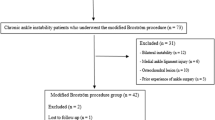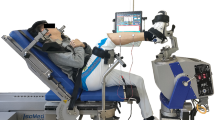Abstract
Purpose
The purpose of this study was to investigate the effect of chronic ankle instability (CAI) on electromechanical delay times (EMD) before and after fatigue. Understanding the mechanisms that contribute to CAI is essential for the development of effective rehabilitation programmes. It was hypothesized that patients with CAI will demonstrate prolonged EMD times compared to healthy subjects and that fatigue will cause greater increases in EMD times in the CAI group.
Methods
Twenty-one male volunteers participated in the study providing data on 16 ankles with CAI and 26 with no history of ankle injury. EMD was measured on an isokinetic dynamometer. Measurements were taken with the ankle in neutral (0°) and at 30° of inversion. All subjects followed an isokinetic fatigue protocol until eversion torque fell below 50 % of initial torque for three consecutive repetitions. A 2 × 2 × 2 ANOVA was used to calculate the effect of ankle status (CAI vs. healthy), fatigue, angle (0° vs. 30°) and their interactions on EMD.
Results
Fatigue caused a significant increase on EMD [non-fatigued: 122(29)ms vs. fatigue 155(54)ms; p < 0.001]. EMD times were shorter at 30° of inversion compared to neutral [neutral: 145(39)ms vs. 30° of inversion: 132(40)ms, p = 0.015]. An interaction effect for ankle status and angle was found (p = 0.026) with CAI ankles demonstrating longer EMD [CAI: 156(45)ms vs. healthy: 133(40)ms] in neutral but not at 30° of inversion [CAI: 133(46)ms vs. 132(33)ms].
Conclusions
Patients with CAI had longer EMD times in neutral, but not when the ankle was placed in inversion. This suggests that rehabilitation programmes may be more effective when retraining occurs with the ankle in neutral position. It is likely that low EMD times prevent ankle acceleration at the beginning of the mechanism of injury, but they are less important when the ankle has already inverted at 30°. Both CAI and healthy subjects demonstrated longer EMD after fatigue, emphasizing the importance of proper conditioning in the prevention of delayed peroneal response and subsequent ankle injury. Improving resistance to fatigue of the peroneals may prove to be an effective prevention tool of ankle sprain recurrence in patients with CAI.
Level of evidence
III.
Similar content being viewed by others
References
Bigland-Ritchie B, Woods JJ (1984) Changes in muscle contractile properties and neural control during human muscular fatigue. Muscle Nerve 7(9):691–699
Cavanagh PR, Komi PV (1979) Electromechanical delay in human skeletal muscle under concentric and eccentric contractions. Eur J Appl Physiol Occup Physiol 42(3):159–163
Demeritt KM, Shultz SJ, Docherty CL, Gansneder BM, Perrin DH (2002) Chronic ankle instability does not affect lower extremity functional performance. J Athl Train 37(4):507–511
Fernandez WG, Yard EE, Comstock RD (2007) Epidemiology of lower extremity injuries among U.S. high school athletes. Acad Emerg Med 14(7):641–645
Forestier N, Teasdale N, Nougier V (2002) Alteration of the position sense at the ankle induced by muscular fatigue in humans. Med Sci Sports Exerc 34(1):117–122
Gabriel DA, Boucher JP (1998) Effects of repetitive dynamic contractions upon electromechanical delay. Eur J Appl Physiol Occup Physiol 79(1):37–40
Garrick JG (1977) The frequency of injury, mechanism of injury, and epidemiology of ankle sprains. Am J Sports Med 5(6):241–242
Garrick JG, Requa RK (1989) The epidemiology of foot and ankle injuries in sports. Clin Podiatr Med Surg 6(3):629–637
Gutierrez GM, Jackson ND, Dorr KA, Margiotta SE, Kaminski TW (2007) Effect of fatigue on neuromuscular function at the ankle. J Sport Rehabil 16(4):295–306
Holmer P, Sondergaard L, Konradsen L, Nielsen PT, Jorgensen LN (1994) Epidemiology of sprains in the lateral ankle and foot. Foot Ankle Int 15(2):72–74
Hootman JM, Dick R, Agel J (2007) Epidemiology of collegiate injuries for 15 sports: summary and recommendations for injury prevention initiatives. J Athl Train 42(2):311–319
Hopkins JT, Brown TN, Christensen L, Palmieri-Smith RM (2009) Deficits in peroneal latency and electromechanical delay in patients with functional ankle instability. J Orthop Res 27(12):1541–1546
Keles SB, Sekir U, Gur H, Akova B (2014) Eccentric/concentric training of ankle evertor and dorsiflexors in recreational athletes: muscle latency and strength. Scand J Med Sci Sports 24(1):e29–e38
Konradsen L (2002) Sensori-motor control of the uninjured and injured human ankle. J Electromyogr Kinesiol 12(3):199–203
Kubo K, Akima H, Kouzaki M et al (2000) Changes in the elastic properties of tendon structures following 20 days bed-rest in humans. Eur J Appl Physiol 83(6):463–468
Lentell G, Baas B, Lopez D, McGuire L, Sarrels M, Snyder P (1995) The contributions of proprioceptive deficits, muscle function, and anatomic laxity to functional instability of the ankle. J Orthop Sports Phys Ther 21(4):206–215
Maclaren DP, Gibson H, Parry-Billings M, Edwards RH (1989) A review of metabolic and physiological factors in fatigue. Exerc Sport Sci Rev 17:29–66
McLoda TA, Stanek JM, Hansen AJ, McCaw ST (2009) A task failure has no effect on the electromechanical delay of the peroneus longus. Electromyogr Clin Neurophysiol 49(2–3):109–115
Mora I, Quinteiro-Blondin S, Perot C (2003) Electromechanical assessment of ankle stability. Eur J Appl Physiol 88(6):558–564
Norman RW, Komi PV (1979) Electromechanical delay in skeletal muscle under normal movement conditions. Acta Physiol Scand 106(3):241–248
Richie DH Jr (2001) Functional instability of the ankle and the role of neuromuscular control: a comprehensive review. J Foot Ankle Surg 40(4):240–251
Tropp H (1986) Pronator muscle weakness in functional instability of the ankle joint. Int J Sports Med 7(5):291–294
Vaes P, Duquet W, Van Gheluwe B (2002) Peroneal reaction times and eversion motor response in healthy and unstable ankles. J Athl Train 37(4):475–480
Vaes P, Van Gheluwe B, Duquet W (2001) Control of acceleration during sudden ankle supination in people with unstable ankles. J Orthop Sports Phys Ther 31(12):741–752
Verhagen RA, de Keizer G, van Dijk CN (1995) Long-term follow-up of inversion trauma of the ankle. Arch Orthop Trauma Surg 114(2):92–96
Vos EJ, Harlaar J, van Ingen Schenau GJ (1991) Electromechanical delay during knee extensor contractions. Med Sci Sports Exerc 23(10):1187–1193
Weil LS, Moore JW, Kratzer CD, Turner DL (1979) A biomechanical study of lateral ankle sprains in basketball. J Am Podiatry Assoc 69(11):687–690
Westerblad H, Lee JA, Lannergren J, Allen DG (1991) Cellular mechanisms of fatigue in skeletal muscle. Am J Physiol 261(2 Pt 1):C195–C209
Yeung MS, Chan KM, So CH, Yuan WY (1994) An epidemiological survey on ankle sprain. Br J Sports Med 28(2):112–116
Zhou S, Carey MF, Snow RJ, Lawson DL, Morrison WE (1998) Effects of muscle fatigue and temperature on electromechanical delay. Electromyogr Clin Neurophysiol 38(2):67–73
Zhou S, Lawson DL, Morrison WE, Fairweather I (1995) Electromechanical delay in isometric muscle contractions evoked by voluntary, reflex and electrical stimulation. Eur J Appl Physiol Occup Physiol 70(2):138–145
Zhou S, McKenna MJ, Lawson DL, Morrison WE, Fairweather I (1996) Effects of fatigue and sprint training on electromechanical delay of knee extensor muscles. Eur J Appl Physiol Occup Physiol 72(5–6):410–416
Author information
Authors and Affiliations
Corresponding author
Rights and permissions
About this article
Cite this article
Flevas, D.A., Bernard, M., Ristanis, S. et al. Peroneal electromechanical delay and fatigue in patients with chronic ankle instability. Knee Surg Sports Traumatol Arthrosc 25, 1903–1907 (2017). https://doi.org/10.1007/s00167-016-4243-6
Received:
Accepted:
Published:
Issue Date:
DOI: https://doi.org/10.1007/s00167-016-4243-6




